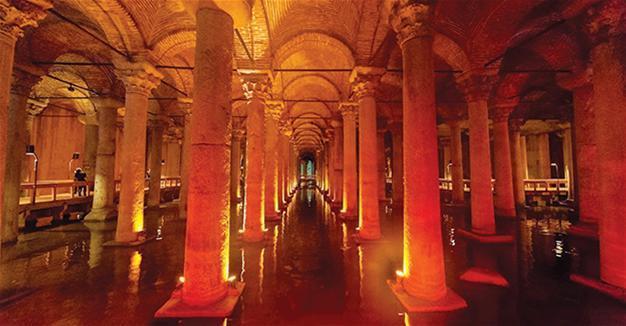Istanbul's Yerebatan Cistern undergoes restoration after 500 years
ISTANBUL

AA photo
The historic Yerebatan (Basilica) Cistern, which is Turkey’s third most visited spot in Istanbul’s historic Sultanahmet district, has been undergoing a comprehensive restoration process for the first time after 500 years.
The restoration, carried out by Hera Restoration, will last for 450 days and end on March 11, 2018. The cistern will be open to visitors during the restoration process.
The works are expected to rearrange the entrance and exit sections of the cistern due to overcrowding at the entrance of the cistern, where visitor queues have occasionally extended to the streets and caused discomfort among visitors. The entrance will be covered with a glass roof and a waiting area will be built.
The restoration plan also includes maintenance works on the walking route inside the cistern. Particularly on rainy days, the ceiling has caused water leakages, causing slippery surfaces. An isolation system will be made on the ceiling.
The reinforced concrete platform in the cistern structure will be removed and replaced with a new platform to be built with modern materials.
The cistern’s columns, walls and vaults will also be reinforced with the guidance of a technical report. The columns that were reinforced in previous restorations will be removed and restored to their original.
The 4thcentury Million Stone, which is located in the park next to the cistern and recognized as the beginning of all ancient Roman ways and the center of the world and the 16th century water gage will also undergo restoration.
Located opposite to the Hagia Sophia in Sultanahmet in the historical peninsula, the cistern was built by Byzantine Emperor Justinian I in 542. The cistern, which is 140 meters in length and 70 meters in width, is accessed via a 520-step-stone staircase. In the cistern, there are 336 columns, each of which is nine meters in length, which most of them are thought to have been removed from old structures. Among them 295 columns are in the open area and 41 are in the closed area.
The Yerebatan Cistern covers an area of 8,678 square meters; of which 7,648 square meters is open area and 1030 square meters is closed area. The cistern has a storage capacity of 100,000 tons of water.
Two upside-down Medusa bases below two columns in the northwestern corner of the cistern are considered to be masterpieces of Roman-era sculpture and are the most popular parts of the cistern for visitors. It is still a mystery as to where the sculptures were brought to the cistern.
It is one of the most important spots for tourists visiting Istanbul from all around the world. The cistern was restored by the Istanbul Metropolitan Municipality and opened to visitors in 1987.
